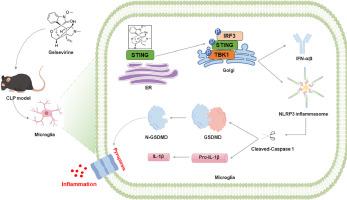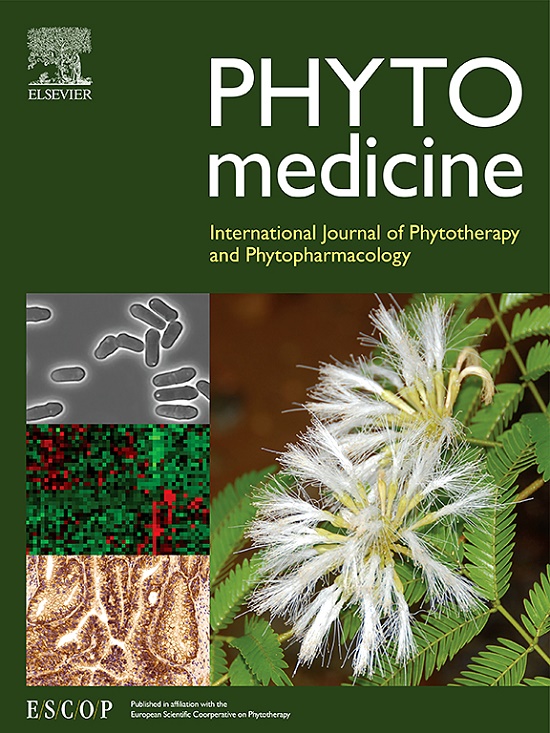格塞韦林通过抑制小胶质细胞中 STING 信号介导的脓毒症通路来改善败血症相关脑病
IF 6.7
1区 医学
Q1 CHEMISTRY, MEDICINAL
引用次数: 0
摘要
背景败血症相关脑病(SAE)是败血症最常见和最致命的并发症之一,但目前还缺乏令人满意的治疗方法和治疗药物。Gelsevirine 是一种提取自 Gelsemium elegans Benth. 的活性成分,已在焦虑、缺血性中风和骨关节炎动物模型中显示出良好的效果。方法我们构建了一个盲肠结扎和穿刺(CLP)诱导的败血症小鼠模型,并通过评估存活率和行为改变来探讨吉西韦林对SAE小鼠的保护作用。为了进一步探索其作用机制,我们通过 Western 印迹、免疫组化染色和 PCR 研究了吉赛韦林对炎症因子、小胶质细胞活化和脓毒症的调节作用。结果 吉赛韦林提高了SAE小鼠的存活率。莫里斯水迷宫和野外测试表明,吉赛韦林能显著缓解SAE小鼠的认知功能障碍并增加其探索行为。Gelsevirine 可抑制小胶质细胞的活化,降低 SAE 小鼠海马中的炎症因子水平。在患有 SAE 的小鼠和体外 BV2 小胶质细胞中,格列卫可降低炎症因子水平,抑制 STING 蛋白磷酸化和小胶质细胞的脓毒症。结论:吉尔赛韦林提高了SAE小鼠海马的存活率,改善了认知障碍,抑制了神经胶质细胞的活化,减轻了炎症反应;其机制可能与抑制STING信号通路介导的小胶质细胞热凋亡有关。本文章由计算机程序翻译,如有差异,请以英文原文为准。

Gelsevirine ameliorates sepsis-associated encephalopathy by inhibiting the STING signalling-mediated pyroptosis pathway in microglia
Background
Sepsis-associated encephalopathy (SAE) is among the most prevalent and deadly complications associated with sepsis, but satisfactory treatments and therapeutic agents are lacking. Gelsevirine, an active ingredient derived from Gelsemium elegans Benth., has shown promising effects in animal models of anxiety, ischaemic stroke and osteoarthritis. However, its protective effect against SAE and its mechanism of action are still unknown.
Purpose
To elucidate the efficacy of gelsevirine against SAE and the mechanism of its protective effect through the STING signalling-mediated pyroptosis pathway.
Methods
We constructed a mouse model of caecum ligation and puncture (CLP)-induced sepsis and explored the protective effects of gelsevirine in mice with SAE by assessing survival rates and behavioural alterations. To further explore its mechanism of action, we investigated the modulatory effects of gelsevirine on the levels of inflammatory factors, microglial activation and pyroptosis by Western blotting, immunohistochemistry staining and PCR. STING knockout mice were used to verify the protective effect of gelsevirine against SAE through the STING pathway.
Results
Gelsevirine increased the survival rate of mice with SAE. The Morris water maze and open field tests revealed that gelsevirine significantly alleviated cognitive dysfunction and increased exploratory behaviour in mice with SAE. Gelsevirine inhibited the activation of microglia and decreased inflammatory factor levels in the hippocampus of mice with SAE. In mice with SAE and in vitro BV2 microglia, gelsevirine reduced levels of inflammatory factors and inhibited STING protein phosphorylation and microglial pyroptosis. However, after STING knockout, the inhibitory effect of gelsevirine on microglial pyroptosis was significantly weakened, and gelsevirine-mediated protective effects were abolished.
Conclusions
Gelsevirine increased the survival rate, ameliorated cognitive impairment, inhibited glial cell activation and reduced inflammation in the hippocampi of mice with SAE; the mechanism may be related to the inhibition of STING signalling pathway-mediated pyroptosis in microglia.
求助全文
通过发布文献求助,成功后即可免费获取论文全文。
去求助
来源期刊

Phytomedicine
医学-药学
CiteScore
10.30
自引率
5.10%
发文量
670
审稿时长
91 days
期刊介绍:
Phytomedicine is a therapy-oriented journal that publishes innovative studies on the efficacy, safety, quality, and mechanisms of action of specified plant extracts, phytopharmaceuticals, and their isolated constituents. This includes clinical, pharmacological, pharmacokinetic, and toxicological studies of herbal medicinal products, preparations, and purified compounds with defined and consistent quality, ensuring reproducible pharmacological activity. Founded in 1994, Phytomedicine aims to focus and stimulate research in this field and establish internationally accepted scientific standards for pharmacological studies, proof of clinical efficacy, and safety of phytomedicines.
 求助内容:
求助内容: 应助结果提醒方式:
应助结果提醒方式:


